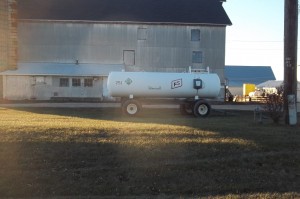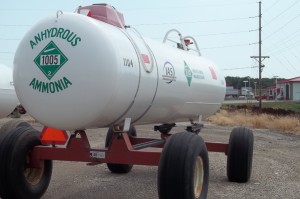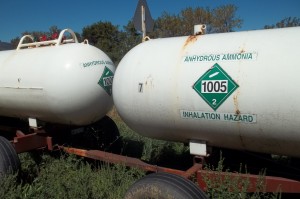 If you live in or near an area where farming is a significant part of the economy, then you are probably familiar with the site of a truck or tractor pulling a trailer with one or more nurse tanks of anhydrous ammonia. The purpose of this article is to identify and explain the applicable Hazardous Material Regulations of PHMSA/USDOT for the transportation in commerce of anhydrous ammonia in nurse tanks by motor vehicle (i.e. highway).
If you live in or near an area where farming is a significant part of the economy, then you are probably familiar with the site of a truck or tractor pulling a trailer with one or more nurse tanks of anhydrous ammonia. The purpose of this article is to identify and explain the applicable Hazardous Material Regulations of PHMSA/USDOT for the transportation in commerce of anhydrous ammonia in nurse tanks by motor vehicle (i.e. highway).
We begin in the hazardous materials table, found in 49 CFR 172.101 of the HMR. The entries for anhydrous ammonia can be seen below.
Anhydrous ammonia is not acceptable as a proper shipping name. Ammonia, anhydrous must be used.
The two entries for Ammonia, anhydrous can be explained by the presence of the “I” and “D” in column 1 for each entry. According to 49 CFR 172.101(b), the two symbols have the following meaning:
The letter “D” in column 1 indicates a proper shipping name that is acceptable for use in domestic transportation but may not be acceptable for international transportation.- The letter “I” in column 1 indicates a proper shipping name that is acceptable for international transportation by may not be acceptable for transportation within the U.S.
Read this article to learn more about the Symbols in Column 1 of the Hazardous Materials Table.
This article will focus solely on transportation within the U.S.
It is interesting to note that within the U.S. anhydrous ammonia is a Division 2.2 Non-Flammable Gas, whereas by international regulations it is a Division 2.3 Poison Gas with a Class 8 Corrosive subsidiary hazard.
When transported as a bulk packaging, column 8 of the hazardous materials table indicates packing instructions can be found either in 49 CFR 172.314 for rail road tank cars, or §173.315 for compressed gases in cargo tanks and portable tanks. But wait! The title of this article is for transportation by nurse tank, not a cargo tank or portable tank. What gives? Though not defined anywhere in the HMR, 49 CFR 173.315(m) explains the relationship between a nurse tank and a cargo tank in this way, “A cargo tank that is commonly known as a nurse tank…” In other words, a nurse tank is a form of cargo tank, and – as we’ll see in a little bit – is not specification packaging. The applicability of §173.315(m) is limited to a nurse tank that meets all of the following conditions:
- Considered an implement of husbandry.
- Used to transport anhydrous ammonia.
- Operated by a private motor carrier.
- Use exclusively for agricultural purposes.
This letter of interpretation from PHMSA helps to explain what is meant by “…implement of husbandry…” and “…a private motor carrier used exclusively for agricultural purposes…” (LOI 11-0116).
Pursuant to §173.315(m), a nurse tank does not need to be specification packaging (i.e. “is excepted from the specification requirements of part 178 of this subchapter…”) if it also complies with the following:
- Has a minimum design pressure of 250 psig, meets the requirements of the edition of Section VIII of the ASME Code in effect at the time it was manufactured, and is marked with a valid ASME plate. However, according to 49 CFR 173.315(m)(2), a nurse tank with a missing or illegible ASME plate may continue to be used if it meets the requirements of subparagraphs §173.315(m)(2)(i-vi).
- Is equipped with pressure relief valves meeting the requirements of CGA Standard S-1.2 (IBR, see §171.7 of this subchapter).
- Is painted white or aluminum.
- Has a capacity of 3,000 gallons or less.
- Is loaded to a filling density no greater than 56%.
- Is securely mounted on a farm wagon or field truck as explained in (m)(3), and later in this article.
- Complies with the requirements of 49 CFR Part 172 for…
- Hazard communication: shipping papers, placards, labels, & markings (with some exceptions explained below).
- HazMat Employee training.
- Safety & Security Plan and In-Depth Security training.
If a nurse tank is used for anhydrous ammonia according to the specified conditions and complies with the requirements of 49 CFR 173.315(m)(1)(i-vii) listed above, then it is subject to the following exceptions:
- Shipping papers are not required. As a result of this, the emergency response information of 49 CFR 172, Subpart G is not required either.
- Does not need to be marked or placarded on one end if that end contains valves, fittings, regulators, or gauges that would prevent them from being properly placed and visible.

Let’s take a closer look at the necessary hazard communication methods when shipping or transporting anhydrous ammonia in a nurse tank:
- Shipping paper not required per 49 CFR 173.315(m)(1)(vii).
- HazMat labels not required on bulk packaging of this type and capacity per §172.400(a).
- In general, placards are required on all four sides (i.e. “…on each side and each end…”) of a cargo tank pursuant to §172.504(a). And, as a bulk packaging, a nurse tank of anhydrous ammonia must display the placard for Division 2.2 Non-Flammable Gas. However, §172.507 re-states the condition of §173.315(m)(1)(vii), “A nurse tank, meeting the provisions of §173.315(m) of this subchapter, is not required to be placarded on an end containing valves, fittings, regulators or gauges when those appurtenances prevent the markings and placard from being properly placed and visible.” So, one side of a nurse tank of anhydrous ammonia does not need to display the required placard. Also, special condition 13 in column 7 of the hazardous materials table for this entry states that the requirements of §172.505 (displaying Poison Gas or Poison Inhalation Hazard placards) don’t apply.

- The general marking requirements for a compressed gas in a cargo tank are the identification number (UN1005) pursuant to §172.332(a) and the proper shipping name or common name (Anhydrous Ammonia) pursuant to §172.328(b), “…on each side and each end…”. However, the regulations requiring both the identification number at §172.302(a) and the proper shipping name of a compressed gas at §172.328(b) allow for the exception from marking a nurse tank on one of its four sides if appurtenances on the nurse tank may prevent its proper display. Here, as well as for placards, the required markings do not need to be displayed on all four sides of a nurse tank of anhydrous ammonia. We’re not done with markings, however, because special condition 13 in column 7 of the hazardous materials table for this entry requires the words “Inhalation Hazard” to be marked on two opposing sides of a bulk package, which in this case is our nurse tank.
 So, the required markings & placards on a nurse tank of anhydrous ammonia must include at a minimum:
So, the required markings & placards on a nurse tank of anhydrous ammonia must include at a minimum:
- Division 2.2 Non-Flammable Gas placard on each side and each end except for one side or end if appurtenances prevent its proper display.
- The identification number (1005) on each side and each end except for one side or end if appurtenances prevent its proper display.
- The proper shipping name or common name on each side and each end except for one side or end if appurtenances prevent its proper display.
- The words “Inhalation Hazard” on two sides.
49 CFR 173.315(m)(3) describes the conditions (somewhat vaguely, read this letter of interpretation for more guidance: LOI-12-0203) that a non-DOT specification nurse tank may be transported while “securely mounted” on a field truck as opposed to on a farm wagon. Conditions for applicability include:
- Conformance with all of 49 CFR 173.315(m)(1), except the requirement to use a farm wagon, natch!
- Inspected and tested per 49 CFR 180, Subpart E as specified for an MC 331 cargo tank.
- May only travel on rural roads within 50 miles of the fertilizer distribution point where it was loaded.
- The field truck must be designed to withstand off-road driving on hilly terrain, have low over-the-road mileage, and be used exclusively for agriculture.
There’s more, e.g. the requirements for an emergency discharge control at §172.315(n). But, the use of this exception lessens the compliance responsibilities of both shippers and carriers of anhydrous ammonia in nurse tanks and allows for variations in how it is transported (LOI-0015).
Be sure to give farmers plenty of room on the road but also take a moment to observe the packaging and hazard communication methods in use when anhydrous ammonia is transported by highway in nurse tanks.
|
Contact me with any questions you may have about the transportation of hazardous materials by air, highway, vessel, or rail International and Domestic Daniels Training Services 815.821.1550 |
And of course, don’t hesitate to contact me with any questions you may have about the transportation of hazardous materials.

